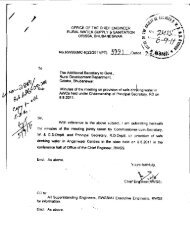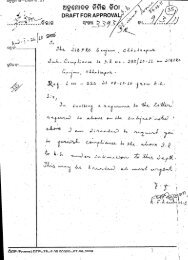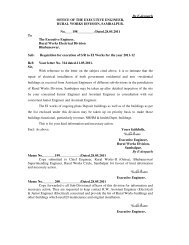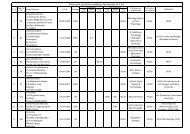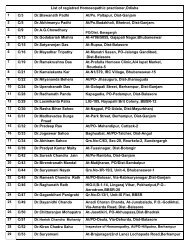Annual Report 2003-2004
Annual Report 2003-2004
Annual Report 2003-2004
Create successful ePaper yourself
Turn your PDF publications into a flip-book with our unique Google optimized e-Paper software.
IEC activities, will, however, cover all the families in the district, without<br />
exception.<br />
Construction of dry latrines should not be discouraged. The existing<br />
dry latrines, if any, should be converted to pour flush latrines and the unit<br />
cost and sharing pattern shall be identical to that of construction of<br />
individual household latrines.<br />
3. Women Sanitary Complex<br />
Community Sanitary Complex is an important component of TSC.<br />
These Complexes can be set up in a place in the village acceptable to<br />
women/ men/ landless families and accessible to them. The maintenance<br />
of such complexes is very essential for which Gram Panchayat should own<br />
the ultimate responsibility or make alternative arrangements at the village<br />
level. Maximum unit cost prescribed for a community complex is Rs. 2<br />
lakh. However, the National Scheme Sanctioning Committee based on the<br />
detailed design and estimates will approve it. Sharing pattern amongst<br />
Central Government, State Government and the community is in the ratio<br />
of 60:20:20. The Panchayat, however, can make the community<br />
contribution. There will not be any upper ceiling for expenditure on this<br />
item. However, total expenditure proposed on Community Sanitary<br />
Complex and Individual Household Toilets should be within the ceiling of<br />
60 percent of the total Government outlay. Ordinarily such complexes<br />
should be constructed only when there is lack of space in the village for<br />
construction of household toilets and the community takes the<br />
responsibility of their operation and maintenance. The ultimate aim is to<br />
ensure construction of maximum IHLs and construction of community<br />
complexes will be restricted to only when IHLs cannot be constructed, for<br />
whatever reason, and also teach the community of Hygiene practices.<br />
Such complexes can be made at public places, markets, etc. where largescale<br />
congregation of people takes place.<br />
4. School Sanitation and Hygiene Education<br />
Children are more receptive to new ideas. Schools/Anganwadis are<br />
appropriate institutions for changing the behaviour, mindset and habits of<br />
children from open defecation to the use of lavatory through motivation<br />
and education. The experience gained by children through use of toilets in<br />
school and sanitation education imparted by teachers would reach home<br />
and would also influence parents to adopt good sanitary habits. School<br />
Sanitation, therefore, forms an integral part of every TSC Project.




